Investigating the Impact of Tillering on Yield and Yield-Related Traits in European Rice Cultivars
Abstract
:1. Introduction
2. Materials and Methods
2.1. Site Description and Climatic Data
2.2. Plant Material
2.3. Field Setup and Cultural Practice
2.4. Sample Collection and Processing
2.5. Yield Metrics’ Assessment
2.5.1. Assessment of Grain Yield
- Y = net yield of the plot (t).
- A = net area of the plot (m2).
- (100 − MC)/(100 − 14) = conversion factor for grain yield at 14% moisture content.
- (1000)/A = conversion factor for actual harvested area on a hectare basis.
2.5.2. Assessment of Harvest Index (HI)
2.5.3. Assessment of 1000-Grain Weight (1000GW)
2.5.4. Assessment of the Number of Stems (NOS)
2.5.5. Determination of Total Dry Matter (TDM)
2.6. Statistical Analyses and (GGE) Biplot Analysis
3. Results
3.1. Total Dry Matter as Influenced by Cultivar, Tillering, and Their Interaction
3.2. Harvest Index (HI) as Influenced by Cultivar, Tillering, and Their Interaction
3.3. 1000-Grain Weight (1000GW) as Influenced by Cultivar, Tillering, and Their Interaction
3.4. Number of Stems (NOS) as Influenced by Cultivar, Tillering, and Their Interaction
3.5. Grain Yield (Yield) as Influenced by Cultivar, Tillering, and Their Interaction
3.6. Correlation Analysis of Tillering and Agronomic Traits
3.7. Regression Analysis: Quantifying the Impact of Tillering on Yield
3.8. General Linear Model: Deciphering the Influence of the Tiller Type and Cultivar
3.9. Integrating the Results: A Holistic Perspective on Tillering in Rice
- Optimizing Tiller Number: While maximizing the tiller number is generally beneficial for the yield, breeders need to consider the trade-offs with the HI and potential lodging issues.
- Enhancing Tiller Productivity: Improving the individual productivity of tillers, particularly later-emerging tillers, can further enhance yield potential.
- Cultivar Selection: Choosing cultivars with optimal tillering characteristics for specific environments and management practices is crucial for maximizing the yield.
- Resource Management: Optimizing resource management, such as nitrogen fertilization and water availability, can influence tiller production and resource allocation patterns.
3.10. Multivariate Analysis of Tillering Levels Across the Nine Cultivars
3.10.1. Principal Component Analysis (PCA)
- Cluster 1: Mn Dominant: This cluster includes Samba and Ronaldo, characterized by high Mn yields and a steep decline in subsequent tiller yields. This suggests a focus on maximizing Mn productivity, making them suitable for environments where maximizing the individual plant yield is paramount. Breeding efforts could explore ways of improving the performance of early tillers or suppressing late, unproductive tillers (Figure 10).
- Cluster 2: Balanced Tillering: This cluster comprises Mare, Olympiada, Galileo, and Gloria, demonstrating moderate Mn yields and a more gradual decline in tiller yields. This indicates a more balanced resource allocation strategy, potentially advantageous in environments where consistent performance across tillers is favored over maximizing the individual plant yield. Further enhancing the yield potential of all tillers could be a breeding target for this group (Figure 10).
- Cluster 3: Low Overall Yield: This cluster includes Alexandros, Dion, and Luna, exhibiting consistently lower yields across all tillering levels. This suggests fundamental limitations in yield potential, possibly related to nutrient use efficiency or stress tolerance. Breeding strategies should focus on improving the overall yield capacity of these cultivars, rather than manipulating tillering patterns (Figure 10).
3.10.2. Hierarchical Clustering on Principal Components (HCPC)
3.10.3. Genotype Main Effect–Genotype by Environment Interaction Analysis (GGE)
4. Discussion
4.1. Tillering Performance and Implications for Breeding
4.2. Cultivar Performance and Implications for Breeding
4.3. The Interactions Between Cultivar and Tillering in Determining the Rice Yield
4.4. Multivariate Analysis of Tillering and Cultivar Performance
5. Conclusions
Author Contributions
Funding
Institutional Review Board Statement
Data Availability Statement
Acknowledgments
Conflicts of Interest
References
- Khush, G.S. What It Will Take to Feed 5.0 Billion Rice Consumers in 2030. Plant. Mol. Biol. 2005, 59, 1–6. [Google Scholar] [CrossRef] [PubMed]
- Organisation for Economic Co-Operation and Development (OECD). Available online: https://www.oecd.org/en/publications/oecd-fao-agricultural-outlook-2021-2030_19428846-en.html (accessed on 23 August 2024).
- Alexandratos, N.; Bruinsma, J. FAO World Agriculture Towards 2030/2050: The 2012 Revision; ESA Working paper No. 12-03; FAO: Rome, Italy, 2012; Available online: https://www.fao.org/global-perspectives-studies/resources/detail/en/c/411108/ (accessed on 11 July 2024).
- Zhu, C.; Kobayashi, K.; Loladze, I.; Zhu, J.; Jiang, Q.; Xu, X.; Liu, G.; Seneweera, S.; Ebi, K.L.; Drewnowski, A.; et al. Carbon Dioxide (CO2) Levels This Century Will Alter the Protein, Micronutrients, and Vitamin Content of Rice Grains with Potential Health Consequences for the Poorest Rice-Dependent Countries. Sci. Adv. 2018, 4, eaaq1012. [Google Scholar] [CrossRef] [PubMed]
- Sandhu, S.S.; Mahal, S.S.; Vashist, K.K.; Buttar, G.S.; Brar, A.S.; Singh, M. Crop and Water Productivity of Bed Transplanted Rice as Influenced by Various Levels of Nitrogen and Irrigation in Northwest India. Agric. Water Manag. 2012, 104, 32–39. [Google Scholar] [CrossRef]
- Ata-Ul-Karim, S.T.; Yao, X.; Liu, X.; Cao, W.; Zhu, Y. Development of Critical Nitrogen Dilution Curve of Japonica Rice in Yangtze River Reaches. Field Crops Res. 2013, 149, 149–158. [Google Scholar] [CrossRef]
- Cereals for Grain—ELSTAT. Available online: https://www.statistics.gr/en/statistics/-/publication/SPG06/- (accessed on 11 December 2024).
- Map of Rice Cultivation in Greece. Available online: http://wwww.minagric.gr/greek/agro_pol/Maps/rizi1.htm (accessed on 19 August 2024).
- Cereal Statistics—Greece. Available online: https://www.minagric.gr/for-farmer-2/crop-production/dimitriaka/946-statistikadimitriakon (accessed on 11 December 2024).
- Ali, O.A.M.; Zayed, B.A.; Abou El-Enin, M.M.M.; Sheikha, A.F.E.; Kheir, A.M.S.; El-Tahlawy, Y.A.; Nada, W.M.; Shaaban, A. Fusing Genotype and Soil Organic/Inorganic Amendment to Improve Saline-Sodic Properties and Rice Productivity. J. Soil Sci. Plant Nutr. 2024, 24, 2413–2436. [Google Scholar] [CrossRef]
- Sikder, M.R.; Khan, M.H.R. Mitigation of Salt Stress in Rice (Oryza sativa L.) Growth and Yield in Coastal Saline Soil Using Crop Residue-Driven Organic Amendments under Varying Moisture Conditions. Dhaka Univ. J. Biol. Sci. 2024, 33, 1–13. [Google Scholar] [CrossRef]
- Cappelli, A.; Oliva, N.; Cini, E. A Systematic Review of Gluten-Free Dough and Bread: Dough Rheology, Bread Characteristics, and Improvement Strategies. Appl. Sci. 2020, 10, 6559. [Google Scholar] [CrossRef]
- Guerrini, L.; Napoli, M.; Mancini, M.; Masella, P.; Cappelli, A.; Parenti, A.; Orlandini, S. Wheat Grain Composition, Dough Rheology and Bread Quality as Affected by Nitrogen and Sulfur Fertilization and Seeding Density. Agronomy 2020, 10, 233. [Google Scholar] [CrossRef]
- Zhou, N.; Wei, H.; Zhang, H. Response of Milling and Appearance Quality of Rice with Good Eating Quality to Temperature and Solar Radiation in Lower Reaches of Huai River. Agronomy 2021, 11, 77. [Google Scholar] [CrossRef]
- Xu, Y.; Guan, X.; Han, Z.; Zhou, L.; Zhang, Y.; Asad, M.A.U.; Wang, Z.; Jin, R.; Pan, G.; Cheng, F. Combined Effect of Nitrogen Fertilizer Application and High Temperature on Grain Quality Properties of Cooked Rice. Front. Plant Sci. 2022, 13, 874033. [Google Scholar] [CrossRef]
- Counce, P.A.; Wells, B.R. Rice Plant Population Density Effect on Early-Season Nitrogen Requirement. J. Prod. Agric. 1990, 3, 390–393. [Google Scholar] [CrossRef]
- del Moral, M.B.G.; del Moral, L.F.G. Tiller Production and Survival in Relation to Grain Yield in Winter and Spring Barley. Field Crops Res. 1995, 44, 85–93. [Google Scholar] [CrossRef]
- Lafarge, T.A.; Broad, I.J.; Hammer, G.L. Tillering in Grain Sorghum over a Wide Range of Population Densities: Identification of a Common Hierarchy for Tiller Emergence, Leaf Area Development and Fertility. Ann. Bot. 2002, 90, 87–98. [Google Scholar] [CrossRef] [PubMed]
- Deng, F.; Wang, L.; Ren, W.-J.; Mei, X.-F.; Li, S.-X. Optimized Nitrogen Managements and Polyaspartic Acid Urea Improved Dry Matter Production and Yield of Indica Hybrid Rice. Soil Till. Res. 2015, 145, 1–9. [Google Scholar] [CrossRef]
- Deiss, L.; Moraes, A.; Pelissari, A.; Skora Neto, F.; Oliveira, E.B.; Silva, V.P. Oat Tillering and Tiller Traits under Different Nitrogen Levels in an Eucalyptus Agroforestry System in Subtropical Brazil. Cienc. Rural 2014, 44, 71–78. [Google Scholar] [CrossRef]
- Alzueta, I.; Abeledo, L.G.; Mignone, C.M.; Miralles, D.J. Differences between Wheat and Barley in Leaf and Tillering Coordination under Contrasting Nitrogen and Sulfur Conditions. Eur. J. Agron. 2012, 41, 92–102. [Google Scholar] [CrossRef]
- Cassman, K.G. Breaking the Yield Barrier. In Proceedings of the Workshop on Rice Yield Potential in Favorable Environments, Manila, Philippines, 29 November–4 December 1993. [Google Scholar]
- Ahmad, S.; Hussain, A.; Ali, H.; Ahmad, A. Transplanted Fine Rice (Oryza sativa L.) Productivity as Affected by Plant Density and Irrigation Regimes. Int. J. Agric. Biol. 2005, 7, 445–447. [Google Scholar]
- Cu, R.M. Effect of Sheath Blight on Yield in Tropical, Intensive Rice Production System. Plant Dis. 1996, 80, 1103. [Google Scholar] [CrossRef]
- Sahu, K.C.; Ekamber, K.; Mohapatra, P. Tiller Dominance in Rice Is Dependent on Assimilate Concentration of the Panicle during Grain Filling. Indian J. Plant Physiol. 2004, 9, 402–406. [Google Scholar]
- Wang, F.; Cheng, F.-M.; Zhang, G. Difference in Grain Yield and Quality among Tillers in Rice Genotypes Differing in Tillering Capacity. Rice Sci. 2007, 14, 135–140. [Google Scholar] [CrossRef]
- Mohanan, K.V.; Pavithran, K. Chronology of Tiller Emergence and Tiller Orientation in Rice (Oryza sativa L.). Int. J. Rice Res. 2007, 44, 4. [Google Scholar]
- Sakai, H.; Cheng, W.; Chen, C.P.; Hasegawa, T. Short-Term High Nighttime Temperatures Pose an Emerging Risk to Rice Grain Failure. Agric. For. Meteorol. 2022, 314, 108779. [Google Scholar] [CrossRef]
- Jyothsna, K.; Aakash; Reddy, P.M.; Setty, J. Impact of Temperature Variations on Rice Production. Int. J. Environ. Clim. 2024, 14, 1–9. [Google Scholar] [CrossRef]
- Hussain, S.; Khaliq, A.; Ali, B.; Hussain, H.A.; Qadir, T.; Hussain, S. Temperature Extremes: Impact on Rice Growth and Development. In Plant Abiotic Stress Tolerance: Agronomic, Molecular and Biotechnological Approaches; Hasanuzzaman, M., Hakeem, K.R., Nahar, K., Alharby, H.F., Eds.; Springer International Publishing: Cham, Switzerland, 2019; pp. 153–171. ISBN 978-3-030-06118-0. [Google Scholar]
- Guo, E.; Wang, L.; Jiang, S.; Xiang, H.; Shi, Y.; Chen, X.; Cheng, X.; Wang, X.; Zhang, T.; Wang, L.; et al. Impacts of Chilling at the Tillering Phases on Rice Growth and Grain Yield in Northeast China. J. Agron. Crop Sci. 2022, 208, 510–522. [Google Scholar] [CrossRef]
- Zhang, W.; Shi, H.; Cai, S.; Guo, Q.; Dai, Y.; Wang, H.; Wan, S.; Yuan, Y. Rice Growth and Leaf Physiology in Response to Four Levels of Continuous Drought Stress in Southern China. Agronomy 2024, 14, 1579. [Google Scholar] [CrossRef]
- Jarin, A.S.; Islam, M.M.; Rahat, A.; Ahmed, S.; Ghosh, P.; Murata, Y. Drought Stress Tolerance in Rice: Physiological and Biochemical Insights. Int. J. Plant Biol. 2024, 15, 692–718. [Google Scholar] [CrossRef]
- Yuan, R.; Mao, Y.; Zhang, D.; Wang, S.; Zhang, H.; Wu, M.; Ye, M.; Zhang, Z. The Formation of Rice Tillers and Factors Influencing It. Agronomy 2024, 14, 2904. [Google Scholar] [CrossRef]
- Li, X.; Qian, Q.; Fu, Z.; Wang, Y.; Xiong, G.; Zeng, D.; Wang, X.; Liu, X.; Teng, S.; Hiroshi, F.; et al. Control of Tillering in Rice. Nature 2003, 422, 618–621. [Google Scholar] [CrossRef]
- Takeda, T.; Suwa, Y.; Suzuki, M.; Kitano, H.; Ueguchi-Tanaka, M.; Ashikari, M.; Matsuoka, M.; Ueguchi, C. The OsTB1 Gene Negatively Regulates Lateral Branching in Rice. Plant J. 2003, 33, 513–520. [Google Scholar] [CrossRef]
- Zhang, W.; Tao, J.; Chang, Y.; Wang, D.; Wu, Y.; Gu, C.; Tao, W.; Wang, H.; Xie, X.; Zhang, Y. Cytokinin Catabolism and Transport Are Involved in Strigolactone-Modulated Rice Tiller Bud Elongation Fueled by Phosphate and Nitrogen Supply. Plant Physiol. Biochem. 2024, 215, 108982. [Google Scholar] [CrossRef]
- Wang, Y.; Lu, J.W.; Ren, T.; Li, P.F.; Liu, Q.X.; Li, X.K. Effects of Exogenous Cytokinin on Photosynthesis, Senescence, and Yield Performance of Inferior Rice Tillers Grown under Different Nitrogen Regimes. Photosynthetica 2020, 58, 137–145. [Google Scholar] [CrossRef]
- Yang, J.; Luo, D.; Yang, B.; Frommer, W.B.; Eom, J.-S. SWEET11 and 15 as Key Players in Seed Filling in Rice. New Phytol. 2018, 218, 604–615. [Google Scholar] [CrossRef]
- Dubois, M. Sugar Transport from Sheaths to Seeds: A Role for the Kinase SnRK1. Plant Physiol. 2022, 189, 1196–1198. [Google Scholar] [CrossRef]
- Varshney, V.; Singh, J.; Salvi, P. Sugar Signaling and Their Interplay in Mitigating Abiotic Stresses in Plant: A Molecular Perspective. In Smart Plant Breeding for Field Crops in Post-Genomics Era; Sharma, D., Singh, S., Sharma, S.K., Singh, R., Eds.; Springer Nature: Singapore, 2023; pp. 369–393. ISBN 978-981-19821-8-7. [Google Scholar]
- Ren, Y.; Huang, Z.; Jiang, H.; Wang, Z.; Wu, F.; Xiong, Y.; Yao, J. A Heat Stress Responsive NAC Transcription Factor Heterodimer Plays Key Roles in Rice Grain Filling. J. Exp. Bot. 2021, 72, 2947–2964. [Google Scholar] [CrossRef] [PubMed]
- Khush, G.S. Green Revolution: Preparing for the 21st Century. Genome 1999, 42, 646–655. [Google Scholar] [CrossRef] [PubMed]
- Khush, G.S. Breaking the Yield Frontier of Rice. GeoJournal 1995, 35, 329–332. [Google Scholar] [CrossRef]
- Donald, C.M. The Breeding of Crop Ideotypes. Euphytica 1968, 17, 385–403. [Google Scholar] [CrossRef]
- Khush, G.S. Green Revolution: The Way Forward. Nat. Rev. Genet. 2001, 2, 815–822. [Google Scholar] [CrossRef]
- Kebrom, T.H.; Richards, R.A. Physiological Perspectives of Reduced Tillering and Stunting in the Tiller Inhibition (Tin) Mutant of Wheat. Funct. Plant Biol. 2013, 40, 977–985. [Google Scholar] [CrossRef]
- Sakamoto, T.; Matsuoka, M. Generating High-Yielding Varieties by Genetic Manipulation of Plant Architecture. Curr. Opin. Biotechnol. 2004, 15, 144–147. [Google Scholar] [CrossRef]
- Mäkelä, P.; Muurinen, S. Uniculm and Conventional Tillering Barley Accessions under Northern Growing Conditions. J. Agric. Sci. 2012, 150, 335–344. [Google Scholar] [CrossRef]
- Jiao, Y.; Wang, Y.; Xue, D.; Wang, J.; Yan, M.; Liu, G.; Dong, G.; Zeng, D.; Lu, Z.; Zhu, X.; et al. Regulation of OsSPL14 by OsmiR156 Defines Ideal Plant Architecture in Rice. Nat. Genet. 2010, 42, 541–544. [Google Scholar] [CrossRef]
- Miura, K.; Ikeda, M.; Matsubara, A.; Song, X.-J.; Ito, M.; Asano, K.; Matsuoka, M.; Kitano, H.; Ashikari, M. OsSPL14 Promotes Panicle Branching and Higher Grain Productivity in Rice. Nat. Genet. 2010, 42, 545–549. [Google Scholar] [CrossRef] [PubMed]
- Wang, H.; Tong, X.; Tang, L.; Wang, Y.; Zhao, J.; Li, Z.; Liu, X.; Shu, Y.; Yin, M.; Adegoke, T.V.; et al. RLB (RICE LATERAL BRANCH) Recruits PRC2-Mediated H3K27 Tri-Methylation on OsCKX4 to Regulate Lateral Branching. Plant Physiol. 2022, 188, 460–476. [Google Scholar] [CrossRef]
- Wang, H.; Chen, M.; Zhang, D.; Meng, X.; Yan, J.; Chu, J.; Li, J.; Yu, H. Shaping Rice Green Revolution Traits by Engineering ATG Immediate Upstream 5′-UTR Sequences of OsSBI and OsHTD1. Plant Biotechnol. J. 2024, 22, 532–534. [Google Scholar] [CrossRef] [PubMed]
- Rahman, N.M.F.; Malik, W.A.; Kabir, M.S.; Baten, M.A.; Hossain, M.I.; Paul, D.N.R.; Ahmed, R.; Biswas, P.S.; Rahman, M.C.; Rahman, M.S.; et al. 50 Years of Rice Breeding in Bangladesh: Genetic Yield Trends. Theor. Appl. Genet. 2023, 136, 18. [Google Scholar] [CrossRef]
- Yan, W. GGEbiplot—A Windows Application for Graphical Analysis of Multienvironment Trial Data and Other Types of Two-Way Data. Agron. J. 2001, 93, 1111–1118. [Google Scholar] [CrossRef]
- Yan, W. Singular-Value Partitioning in Biplot Analysis of Multienvironment Trial Data. Agron. J. 2002, 94, 990–996. [Google Scholar] [CrossRef]
- Yan, W.; Kang, M.S.; Ma, B.; Woods, S.; Cornelius, P.L. GGE Biplot vs. AMMI Analysis of Genotype-by-Environment Data. Crop Sci. 2007, 47, 643–653. [Google Scholar] [CrossRef]
- Carter, M.R.; Gregorich, E.G. (Eds.) Soil Sampling and Methods of Analysis, 2nd ed.; CRC Press: Boca Raton, FL, USA, 2007; ISBN 978-0-429-12622-2. [Google Scholar]
- Sudianto, E.; Beng-Kah, S.; Ting-Xiang, N.; Saldain, N.E.; Scott, R.C.; Burgos, N.R. Clearfield® Rice: Its Development, Success, and Key Challenges on a Global Perspective. Crop Prot. 2013, 49, 40–51. [Google Scholar] [CrossRef]
- Council Regulation (EC) No 1785/2003 of 29 September 2003 on the Common Organisation of the Market in Rice; 2003; p. 113. Available online: https://eur-lex.europa.eu/legal-content/EN/TXT/?uri=CELEX:32003R1785 (accessed on 23 August 2024).
- Kadoglidou, K.; Kalaitzidis, A.; Stavrakoudis, D.; Mygdalia, A.; Katsantonis, D. A Novel Compost for Rice Cultivation Developed by Rice Industrial By-Products to Serve Circular Economy. Agronomy 2019, 9, 553. [Google Scholar] [CrossRef]
- Ntanos, D.A.; Koutroubas, S.D. Dry Matter and N Accumulation and Translocation for Indica and Japonica Rice under Mediterranean Conditions. Field Crops Res. 2002, 74, 93–101. [Google Scholar] [CrossRef]
- Martinez-Eixarch, M.; Català, M.d.M.; Tomàs, N.; Pla, E.; Zhu, D. Tillering and Yield Formation of a Temperate Japonica Rice Cultivar in a Mediterranean Rice Agrosystem. Span. J. Agric. Res. 2015, 13, e0905. [Google Scholar] [CrossRef]
- Alexander, C.J.; Holland, J.M.; Winder, L.; Woolley, C.; Perry, J.N. Performance of Sampling Strategies in the Presence of Known Spatial Patterns. Ann. Appl. Biol. 2005, 146, 361–370. [Google Scholar] [CrossRef]
- Badar, M.A.; Raman, S.; Pulat, P.S. Experimental Verification of Manufacturing Error Pattern and Its Utilization in Form Tolerance Sampling. Int. J. Mach. Tools Manuf. 2005, 45, 63–73. [Google Scholar] [CrossRef]
- Karki, S.; Poudel, N.S.; Bhusal, G.; Simkhada, S.; Regmi, B.R.; Adhikari, B.; Poudel, S. Growth Parameter and Yield Attributes of Rice (Oryza sativa L.) as Influenced by Different Combination of Nitrogen Sources. World J. Agric. Res. 2018, 6, 58–64. [Google Scholar] [CrossRef]
- Yoshida, S. Fundamentals of Rice Crop Science; International Rice Research Institute: Los Baños, Philippines, 1981; ISBN 978-971-10-4052-9. [Google Scholar]
- Payne, R.W. GenStat. WIREs Comp. Stats 2009, 1, 255–258. [Google Scholar] [CrossRef]
- Wu, G.; Wilson, L.; McClung, A. Contribution of Rice Tillers to Dry Matter Accumulation and Yield. Agron. J. 1998, 90, 317–323. [Google Scholar] [CrossRef]
- Counce, P.A.; Siebenmorgen, T.J.; Poag, M.A.; Holloway, G.E.; Kocher, M.F.; Lu, R. Panicle Emergence of Tiller Types and Grain Yield of Tiller Order for Direct-Seeded Rice Cultivars. Field Crops Res. 1996, 47, 235–242. [Google Scholar] [CrossRef]
- Mohapatra, P.; Ekamber, K. Time of Emergence Determines the Pattern of Dominance of Rice Tillers. Aust. J. Crop Sci. 2008, 1, 53–62. [Google Scholar]
- Wang, Y.; Lu, J.; Ren, T.; Hussain, S.; Guo, C.; Wang, S.; Cong, R.; Li, X. Effects of Nitrogen and Tiller Type on Grain Yield and Physiological Responses in Rice. AoB Plants 2017, 9, plx012. [Google Scholar] [CrossRef]
- Hossain, M.B.; Islam, M.; Hasanuzzaman, M. Influence of Different Nitrogen Levels on the Performance of Four Aromatic Rice Varieties. Int. J. Agric. Biol. 2008, 10, 693–696. [Google Scholar]
- Dutta, R.K.; Mia, M.; Khanam, S. Plant Architecture and Growth Characteristics of Fine Grain and Aromatic Rices and Their Relation with Grain Yield. Int. Rice Comm. Newsl. 2002, 51, 51–56. [Google Scholar]
- Hussain, S.; Fujii, T.; McGoey, S.; Yamada, M.; Ramzan, M.; Akmal, M. Evaluation of Different Rice Varieties for Growth and Yield Characteristics. J. Anim. Plant Sci. 2014, 24, 1504–1510. [Google Scholar]
- Ninou, E.; Tsivelika, N.; Sistanis, I.; Katsenios, N.; Korpetis, E.; Vazaneli, E.; Papathanasiou, F.; Didos, S.; Argiriou, A.; Mylonas, I. Assessment of Durum Wheat Cultivars’ Adaptability to Mediterranean Environments Using G × E Interaction Analysis. Agronomy 2024, 14, 102. [Google Scholar] [CrossRef]
- Mylonas, I.; Sinapidou, E.; Remountakis, E.; Sistanis, I.; Pankou, C.; Ninou, E.; Papadopoulos, I.; Papathanasiou, F.; Lithourgidis, A.; Gekas, F.; et al. Improved Plant Yield Efficiency Alleviates the Erratic Optimum Density in Maize. Agron. J. 2020, 112, 1690–1701. [Google Scholar] [CrossRef]
- Anshori, M.F.; Musa, Y.; Farid, M.; Jayadi, M.; Padjung, R.; Kaimuddin, K.; Huang, Y.C.; Casimero, M.; Bogayong, I.; Suwarno, W.B.; et al. A Comprehensive Multivariate Approach for GxE Interaction Analysis in Early Maturing Rice Varieties. Front. Plant Sci. 2024, 15, 1462981. [Google Scholar] [CrossRef]
- Sinclair, T.R. Historical Changes in Harvest Index and Crop Nitrogen Accumulation. Crop Sci. 1998, 38, 638–643. [Google Scholar] [CrossRef]
- Peltonen-Sainio, P.; Muurinen, S.; Rajala, A.; Jauhiainen, L. Variation in Harvest Index of Modern Spring Barley, Oat and Wheat Cultivars Adapted to Northern Growing Conditions. J. Agric. Sci. 2008, 146, 35–47. [Google Scholar] [CrossRef]
- D’Andrea, K.E.; Otegui, M.E.; de la Vega, A.J. Multi-Attribute Responses of Maize Inbred Lines across Managed Environments. Euphytica 2008, 162, 381–394. [Google Scholar] [CrossRef]
- Hasan, M.; Khan, M.A.; Islam, M.M.; Haque, M. Growth and Productivity of Short Duration Aman Rice Genotype. Bangladesh Agron. J. 2018, 20, 27. [Google Scholar] [CrossRef]
- Saito, H.; Fukuta, Y.; Obara, M.; Tomita, A.; Ishimaru, T.; Sasaki, K.; Fujita, D.; Kobayashi, N. Two Novel QTLs for the Harvest Index That Contribute to High-Yield Production in Rice (Oryza sativa L.). Rice 2021, 14, 18. [Google Scholar] [CrossRef] [PubMed]
- Lim, S.; Onoda, A.; Orn, C.; Iwamoto, H.; Ishikawa, R.; Saito, H.; Sato, Y.; Ishii, T. Variations in Grain Traits among Local Rice Varieties Collected More Than Half-Century Ago in Indochinese Countries. Plants 2023, 12, 133. [Google Scholar] [CrossRef]
- Sun, T.; Yang, X.; Tan, X.; Han, K.; Tang, S.; Tong, W.; Zhu, S.; Hu, Z.; Wu, L. Comparison of Agronomic Performance between Japonica/Indica Hybrid and Japonica Cultivars of Rice Based on Different Nitrogen Rates. Agronomy 2020, 10, 171. [Google Scholar] [CrossRef]


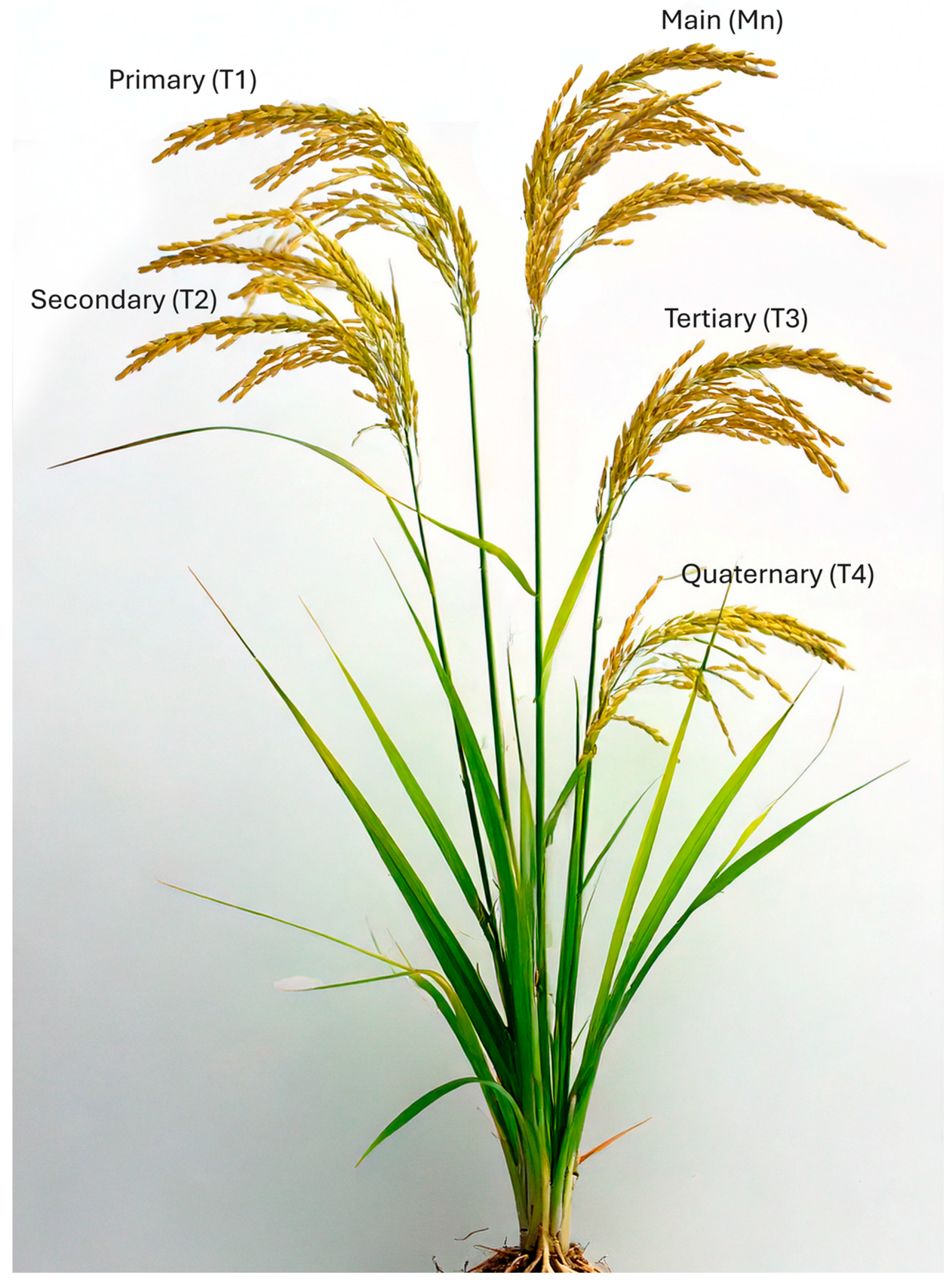

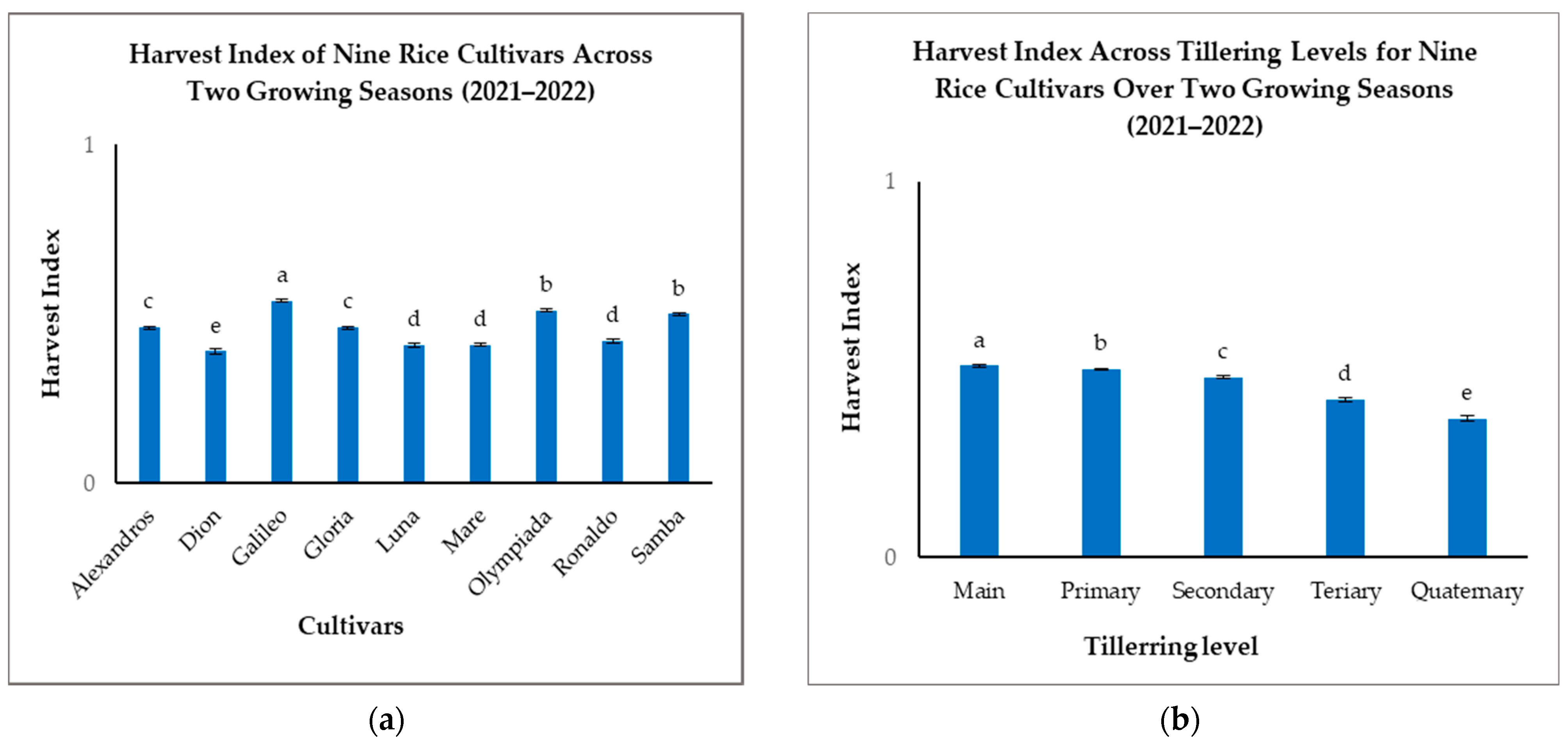

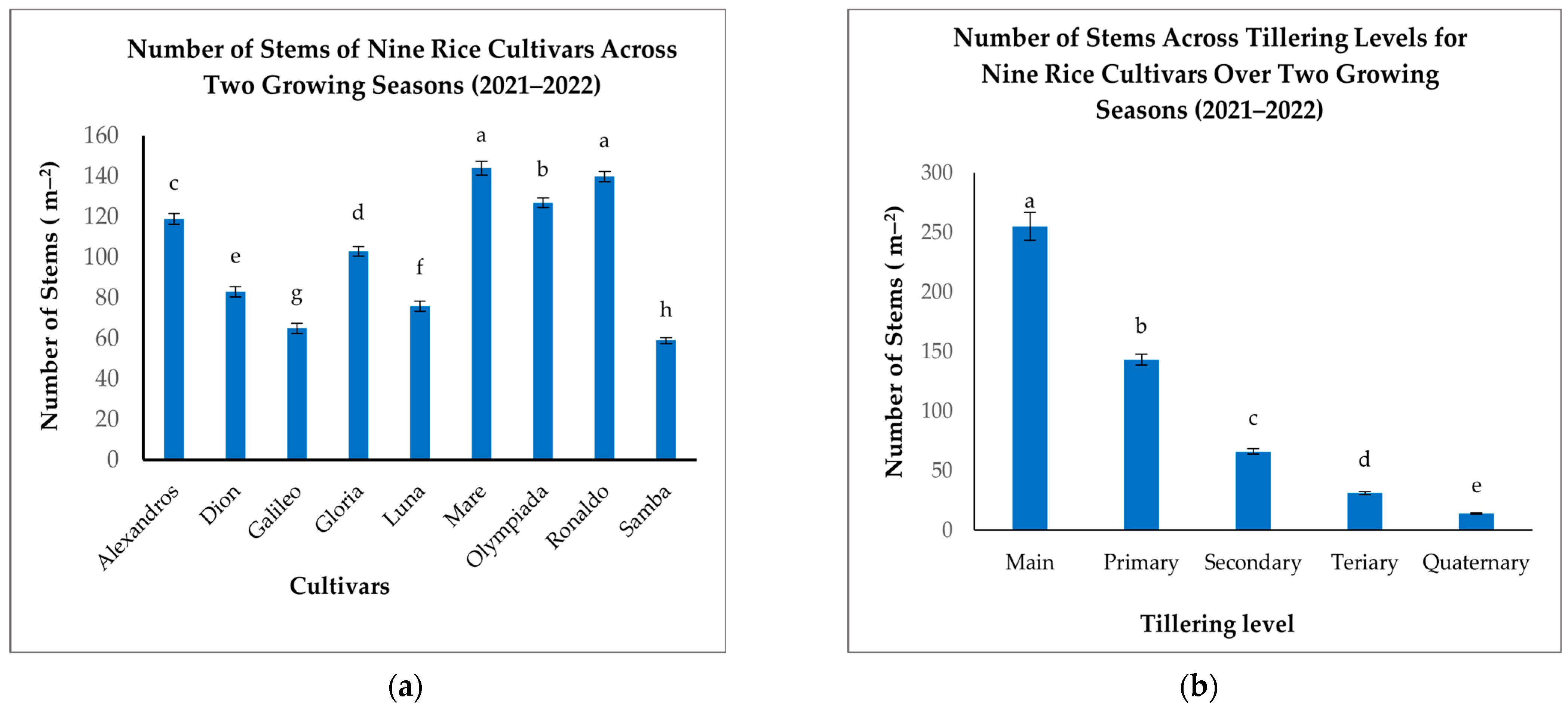
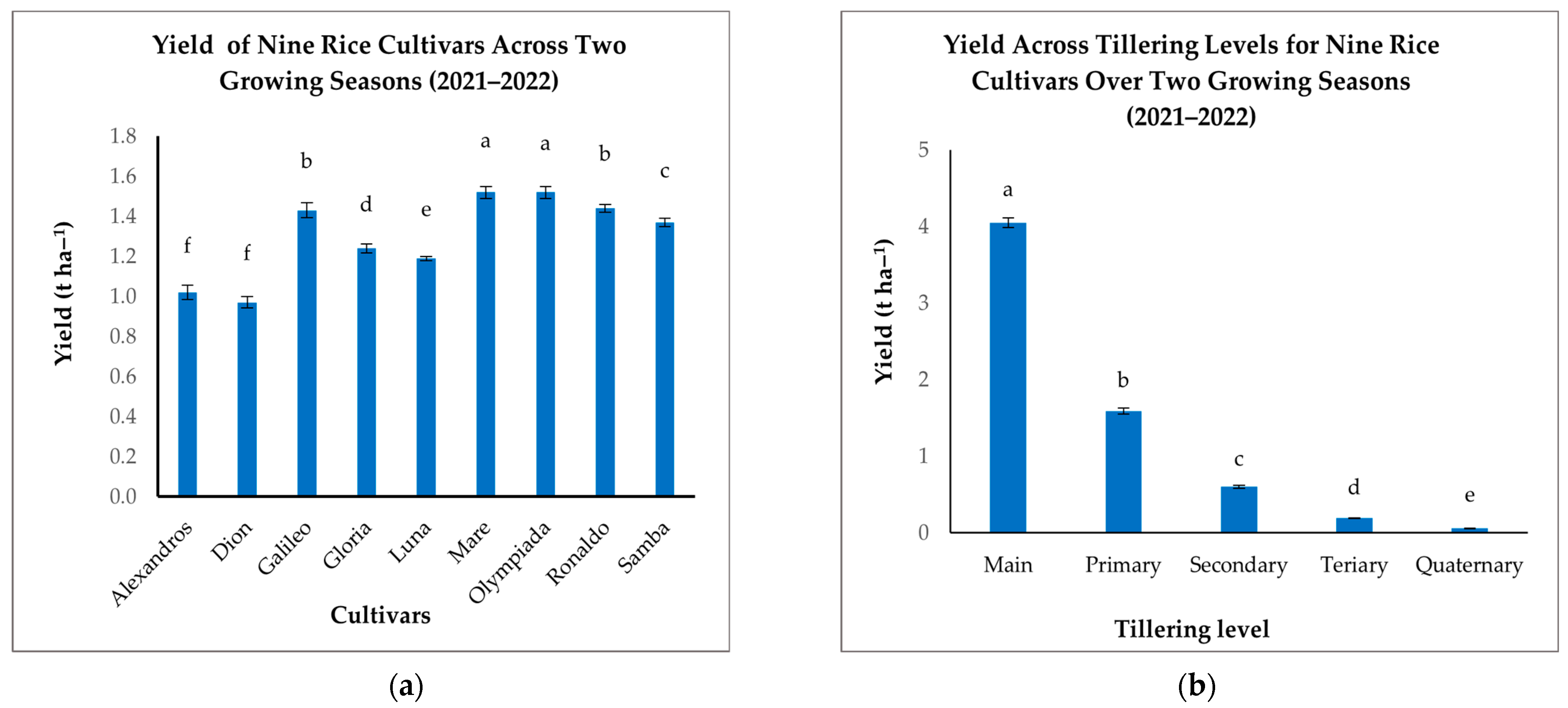

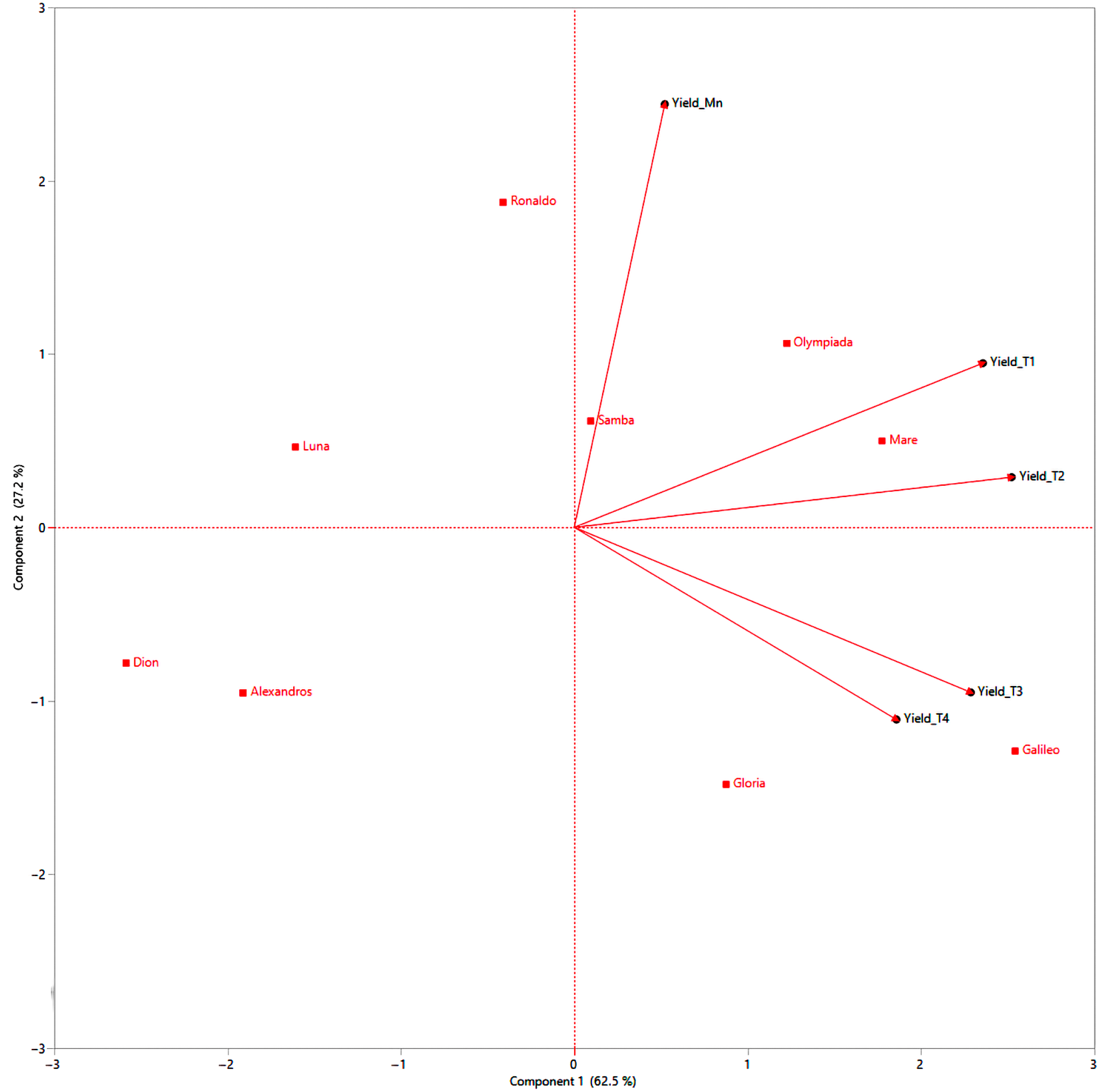


| Cultivar | Type of Cultivar | Growth Cycle | EU Grain Classification |
|---|---|---|---|
| Alexandros | Indica | Medium–Long | Long B |
| Dion | Japonica | Medium | Medium |
| Galileo | Japonica | Long | Long A |
| Gloria | Japonica | Medium | Long A |
| Luna | Japonica | Long | Long A |
| Mare | Indica | Medium–Long | Long B |
| Olympiada | Indica | Medium–Long | Long B |
| Ronaldo | Japonica | Long | Medium |
| Samba | Japonica | Medium | Long A |
| Tillering Level | Cultivars | ||||||||
|---|---|---|---|---|---|---|---|---|---|
| Alexandros | Dion | Galileo | Gloria | Luna | Mare | Olympiada | Ronaldo | Samba | |
| Mn | 6.86 g | 7.32 f | 7.06 g | 6.86 g | 8.63 c | 9.16 b | 7.98 e | 9.45 a | 8.25 d |
| T1 | 2.44 mn | 1.76 o | 3.42 jk | 3.29 k | 2.61 m | 4.88 h | 3.59 j | 3.85 i | 2.98 l |
| T2 | 0.69 rs | 0.49 st | 1.62 op | 1.52 p | 0.74 r | 2.33 n | 1.57 op | 1.28 q | 1.07 q |
| T3 | 0.24 u | 0.17 u | 0.71 rs | 0.74 r | 0.26 u | 0.67 rs | 0.51 st | 0.27 u | 0.24 u |
| T4 | 0.06 u | 0.15 u | 0.31 tu | 0.18 u | 0.09 u | 0.18 tu | 0.11 u | 0.07 u | 0.21 u |
| LSD 1 | 0.20 | ||||||||
| Tillering Level | Cultivars | ||||||||
|---|---|---|---|---|---|---|---|---|---|
| Alexandros | Dion | Galileo | Gloria | Luna | Mare | Olympiada | Ronaldo | Samba | |
| Mn | 0.51 f | 0.50 f | 0.55 bc | 0.51 f | 0.49 ghi | 0.46 lm | 0.56 ab | 0.50 fg | 0.54 de |
| T1 | 0.49 ghi | 0.48 jk | 0.56 a | 0.49 ghi | 0.48 jk | 0.43 p | 0.56 ab | 0.47 l | 0.55 bc |
| T2 | 0.45 no | 0.46 lm | 0.54 de | 0.48 jk | 0.45 no | 0.41 q | 0.54 de | 0.45 no | 0.54 de |
| T3 | 0.39 s | 0.26 v | 0.55 bc | 0.47 l | 0.40 qr | 0.39 s | 0.49 ghi | 0.40 qr | 0.43 p |
| T4 | 0.46 lm | 0.24 w | 0.49 ghi | 0.37 t | 0.25 v | 0.37 t | 0.41 q | 0.30 u | 0.44 op |
| LSD 1 | 0.36 | ||||||||
| Tillering Level | Cultivars | ||||||||
|---|---|---|---|---|---|---|---|---|---|
| Alexandros | Dion | Galileo | Gloria | Luna | Mare | Olympiada | Ronaldo | Samba | |
| Mn | 27.53 l | 27.45 l | 41.65 a | 38.90 cde | 30.85 i | 23.43 rst | 23.25 rst | 30.78 i | 39.91 bc |
| T1 | 27.52 l | 28.59 k | 40.85 ab | 37.10 fg | 30.08 ij | 24.15 pqr | 22.82 stu | 29.75 j | 38.41 de |
| T2 | 26.65 lmn | 27.55 l | 41.45 a | 36.44 g | 29.42 jk | 23.35 rst | 22.52 tu | 29.70 j | 39.38 cd |
| T3 | 24.57 pq | 26.15 mn | 37.90 ef | 35.11 h | 27.16 lm | 23.58 qrs | 22.69 stu | 24.89 op | 38.02 ef |
| T4 | 20.68 v | 22.87 stu | 38.52 de | 34.83 h | 25.81 no | 19.97 v | 20.35 v | 21.96 u | 34.30 h |
| LSD 1 | 1.03 | ||||||||
| Tillering Level | Cultivars | ||||||||
|---|---|---|---|---|---|---|---|---|---|
| Alexandros | Dion | Galileo | Gloria | Luna | Mare | Olympiada | Ronaldo | Samba | |
| Mn | 312.0 c | 220.0 f | 145.0 k | 206.0 g | 243.0 e | 322.0 b | 302.0 d | 394.0 a | 149.0 k |
| T1 | 74.0 i | 123.0 l | 96.0 m | 160.0 j | 89.0 mno | 206.0 g | 172.0 i | 185.0 h | 85.0 mno |
| T2 | 62.0 p | 51.0 qr | 52.0 qr | 83.0 o | 28.0 vw | 129.0 l | 92.0 mn | 58.0 pq | 38.0 tu |
| T3 | 35.0 uv | 15.0 yz | 23.0 wx | 50.0 rs | 11.0 z | 43.0 stu | 46.0 rst | 43.0 stu | 12.0 z |
| T4 | 11.0 z | 6.0 z | 11.0 z | 16.0 xyz | 9.0 z | 18.0 xyz | 21.0 wxy | 22.0 wxy | 11.0 z |
| LSD 1 | 8.6 | ||||||||
| Tillering Level | Cultivars | ||||||||
|---|---|---|---|---|---|---|---|---|---|
| Alexandros | Dion | Galileo | Gloria | Luna | Mare | Olympiada | Ronaldo | Samba | |
| Mn | 3.46 f | 3.68 e | 3.87 d | 3.44 f | 4.23 c | 4.19 c | 4.46 b | 4.71 a | 4.44 b |
| T1 | 1.19 k | 0.84 mn | 1.90 h | 1.62 j | 1.24 k | 2.12 g | 1.99 h | 1.79 i | 1.63 j |
| T2 | 0.31 pqr | 0.23 rs | 0.86 lm | 0.73 n | 0.34 pq | 0.95 l | 0.85 lm | 0.57 o | 0.58 o |
| T3 | 0.09 tu | 0.04 tu | 0.39 p | 0.35 pq | 0.11 tu | 0.26 qr | 0.25 qrs | 0.11 tu | 0.10 tu |
| T4 | 0.03 u | 0.04 u | 0.15 st | 0.07 tu | 0.02 u | 0.07 tu | 0.05 tu | 0.02 u | 0.09 tu |
| LSD 1 | 0.11 | ||||||||
Disclaimer/Publisher’s Note: The statements, opinions and data contained in all publications are solely those of the individual author(s) and contributor(s) and not of MDPI and/or the editor(s). MDPI and/or the editor(s) disclaim responsibility for any injury to people or property resulting from any ideas, methods, instructions or products referred to in the content. |
© 2025 by the authors. Licensee MDPI, Basel, Switzerland. This article is an open access article distributed under the terms and conditions of the Creative Commons Attribution (CC BY) license (https://creativecommons.org/licenses/by/4.0/).
Share and Cite
Kalaitzidis, A.; Kadoglidou, K.; Mylonas, I.; Ghoghoberidze, S.; Ninou, E.; Katsantonis, D. Investigating the Impact of Tillering on Yield and Yield-Related Traits in European Rice Cultivars. Agriculture 2025, 15, 616. https://doi.org/10.3390/agriculture15060616
Kalaitzidis A, Kadoglidou K, Mylonas I, Ghoghoberidze S, Ninou E, Katsantonis D. Investigating the Impact of Tillering on Yield and Yield-Related Traits in European Rice Cultivars. Agriculture. 2025; 15(6):616. https://doi.org/10.3390/agriculture15060616
Chicago/Turabian StyleKalaitzidis, Argyrios, Kalliopi Kadoglidou, Ioannis Mylonas, Sopio Ghoghoberidze, Elissavet Ninou, and Dimitrios Katsantonis. 2025. "Investigating the Impact of Tillering on Yield and Yield-Related Traits in European Rice Cultivars" Agriculture 15, no. 6: 616. https://doi.org/10.3390/agriculture15060616
APA StyleKalaitzidis, A., Kadoglidou, K., Mylonas, I., Ghoghoberidze, S., Ninou, E., & Katsantonis, D. (2025). Investigating the Impact of Tillering on Yield and Yield-Related Traits in European Rice Cultivars. Agriculture, 15(6), 616. https://doi.org/10.3390/agriculture15060616








